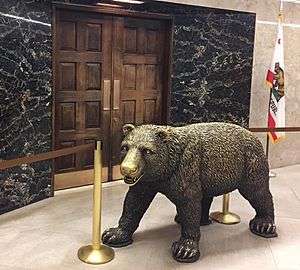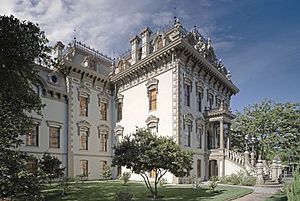Governor of California facts for kids
Quick facts for kids Governor of California |
|
|---|---|

|
|

|
|
| Government of California | |
| Member of | Cabinet Regents of the University of California |
| Residence | Governor's Mansion |
| Seat | California State Capitol (principal workplace) Stanford Mansion (workplace and reception center) |
| Nominator | Political parties |
| Appointer | Popular vote |
| Term length | 4 years, renewable once |
| Constituting instrument | Constitution of California |
| Precursor | |
| Inaugural holder | Peter Hardeman Burnett |
| Formation | December 20, 1849 |
| Succession | Line of succession |
| Deputy | Lieutenant Governor of California |
| Salary | US$224,020 (2022) |
The governor of California is the main leader of the government in the U.S. state of California. Think of them as the state's chief executive. The governor is also the top commander of the California National Guard and the California State Guard.
This important job was created in 1849, just before California became a state. The rules for the governor's role are written in the Constitution of California. These rules explain what the governor needs to do.
Some of the governor's main duties include creating the state's yearly budget. They also make sure that all state laws are followed. Every year, the governor gives a special speech called the State of the State address to the California State Legislature.
A governor can serve for two terms, which means two four-year periods. These terms do not have to be one after another. The current governor of California is Gavin Newsom. He is a member of the Democratic Party and started his term on January 7, 2019. Jerry Brown served the longest as governor. He was governor from 1975 to 1983, and again from 2011 to 2019.
What Does the Governor Do?
The governor of California has many important jobs. These duties are listed in Article 5 of the State Constitution.
- They are the Chief Executive of the state. This means they are in charge of the state government.
- They make sure that all state laws are followed and carried out.
- They have the highest authority over state agencies and departments.
- They choose people to work in state agencies, on boards, and in commissions.
- They can appoint state judges when there are open positions.
- They are the Commander-in-Chief of the California National Guard and the State Military Reserve. This is when these groups are not working for the federal government.
- They can sign bills to make them into laws.
- They can reject bills entirely, which is called a veto. The Legislature can still pass the bill if two-thirds of its members vote for it.
- They can use a line-item veto on budget bills. This means they can reject specific parts of a spending bill without rejecting the whole thing.
- They prepare and present the state budget every year.
- They can approve or reject how much money government programs receive.
- They can call the State Legislature together for special meetings if needed.
- They give the State of the State Address to the Legislature every year.
- They can grant pardons (forgive a crime), commute sentences (reduce a punishment), or issue reprieves (delay a punishment). They cannot do this for cases involving impeachment without the California Supreme Court's approval.
- If a U.S. Senate seat becomes empty, the governor can choose someone to fill it.
- They can use their position to influence public opinion or legislative goals.
How Governors Are Chosen and Removed
Who Can Be Governor?
To become governor, a person must be a U.S. citizen. They must also be a registered voter in California. They cannot have been found guilty of certain serious crimes like bribery or theft. Also, they cannot have served two terms as governor since November 6, 1990.
How Governors Are Elected
Governors are chosen by a direct vote from the people. They serve for four years. A governor can only serve two terms if those terms were after November 6, 1990. Governors take office on the first Monday after January 1 following their election.
When a governor starts their job, they take an oath. This is a promise to support and protect the Constitution of the United States and the California Constitution. They promise to do their duties well and faithfully.
How a Governor Can Be Removed

There are two main ways a governor can be removed from office.
Impeachment by the Legislature
The governor can be impeached for "misconduct in office." This means they can be accused of doing something wrong while in their job. The State Assembly votes on this. If a majority votes to impeach, the governor is then tried by the State Senate. If two-thirds of the Senate votes to remove them, the governor loses their job.
Recall by Voters
People in California can also try to remove a governor through a recall election. This happens if enough voters sign petitions. The number of signatures needed is 12% of the votes from the last governor's election. These signatures must also come from at least five different counties.
If enough signatures are collected, voters then get to vote twice on the same ballot. First, they vote on whether to remove the current governor. Second, they vote for a possible replacement. If most people vote to remove the governor, then the person with the most votes among the replacements becomes the new governor.
California has had two major recall attempts that made it to a vote. In 2003, a petition led to a recall election for Democratic governor Gray Davis. He lost the vote and was replaced by Republican Arnold Schwarzenegger. This was the first time a California governor was removed by a recall vote.
More recently, current governor Gavin Newsom faced a recall election in 2021. However, he won that election and kept his position.
Governor and Lieutenant Governor

California also has a lieutenant governor. This person is elected separately from the governor. They are not chosen as a team, like a president and vice president. Because of this, California has often had a governor and lieutenant governor from different political parties. This happened for almost 27 years between 1978 and 2011.
This can be important because the California Constitution says that the lieutenant governor takes over all the governor's powers when the governor is not in California. This means the lieutenant governor might sign or veto laws or make appointments while the governor is away.
Usually, there is an unspoken agreement that the lieutenant governor will only do routine tasks when the governor is out of state. However, this agreement was broken once by Mike Curb. He signed several orders that went against Governor Jerry Brown's plans when Brown was away. Courts have said that the lieutenant governor does have the right to act as governor when the governor is out of state.
The lieutenant governor also leads the California State Senate.
Where the Governor Lives and Works

The official home for the California governor is the California Governor's Mansion in Sacramento. Fourteen governors have lived there. However, some governors have chosen to live in their own private homes instead. The mansion is also one of the places where the governor works.
The governor's main office is inside the California State Capitol building in Sacramento.
The Leland Stanford Mansion, also in Sacramento, is another official workplace for the governor. It also serves as the main reception center for the California government.
See also
 In Spanish: Gobernador de California para niños
In Spanish: Gobernador de California para niños
- List of governors of California
- List of governors of California before 1850
- Politics of California
- First ladies and partners of California
Images for kids





